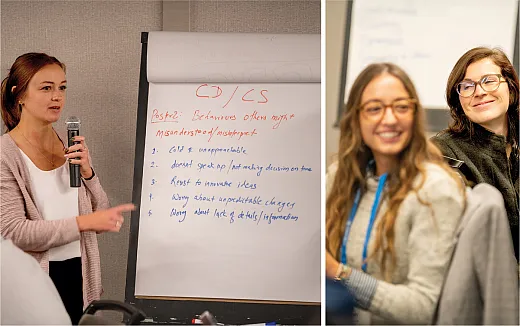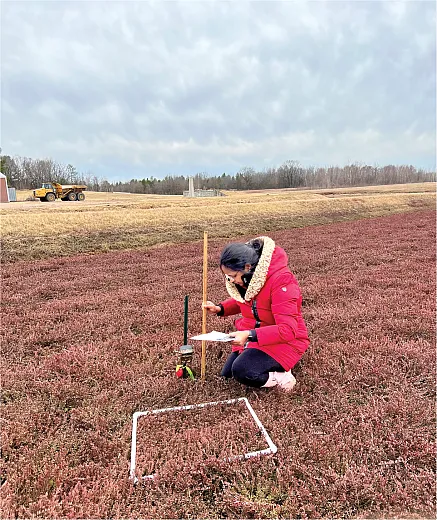The Rise of Early Career Women in Agricultural Science
Overcoming Barriers and Shaping the Future

In recent years, the agricultural sector, like many others, has undergone a phenomenal transformation. The increasing number of women in early careers, including graduate students, postdocs, and emerging scientists, is one of the most remarkable changes. This development signifies a transformation in gender balance and holds the potential to reshape the future of agricultural science. Women encounter many challenges in their pursuit of progress. Recognizing these challenges is the first step toward creating a more inclusive and supportive environment for early career women in agricultural science to not only contribute research, but also push the boundaries, foster innovation, and become leaders.
Challenges Faced by Women in Agricultural Science
Historically, agricultural science was predominantly male‐driven. Women venturing into this realm often encountered biases, both subtle and overt, which sometimes pushed them to the margins. They face challenges that extend beyond the realm of pure science, from unyielding stereotypes, to balancing family and work, to encountering limited opportunities for leadership roles. The following are among these challenges.
From Graduate Students to Emerging Scientists
Many women may not have access to graduate school scholarships or funding opportunities tailored to their needs. Microaggressions, overt racism, and a lack of representation can make the academic journey for women from marginalized communities even more difficult. Even after graduation, women may face biases during job interviews with some employers doubting their physical strength or commitment if they’re in their childbearing years or have family responsibilities.
“Each time a woman stands up for herself, without knowing it possibly, without claiming it, she stands up for all women.”
–Maya Angelou
Access to Resources
Research has shown that women, on average, have less access to essential agricultural resources, be it land, credit, or tools. This disparity also manifests in the research arena where women may face challenges securing equal opportunities for funding or resources.
Academic Pressure, Limited Mentorship, and Lack of Representation
As there are fewer women in senior academic positions, it may be difficult for female graduate students and early career women to find mentors with whom they can relate and discuss gender‐specific challenges. Due to the paucity of women in agricultural science leadership positions, aspiring female scientists have fewer role models to emulate. Representation is important because seeing a person who resembles you in a position of authority can inspire and motivate.
Balancing Personal and Professional Lives
Many women find it difficult to balance their personal lives, particularly familial responsibilities, with their professional goals. With societal expectations weighing heavily on their shoulders, walking the tightrope often becomes exhausting. The challenges that women face in agricultural research are multifaceted and frequently change as they advance in their careers. Each stage of the process, from graduate school classrooms to seasoned scientists’ research labs, presents its own set of challenges. While some barriers are universal and affect all women, others are more nuanced, varying according to career stage or intersecting identities such as race or ethnicity.
Career Breaks and Delayed Career Choices
During pregnancy or after childbirth, many women may take breaks or reduce their work hours. This can sometimes hinder their career momentum, making re‐entering the workforce or climbing the corporate ladder more difficult. Some women might postpone pursuing higher education or accept fewer demanding roles to align with their family‐planning goals.
Physical and Emotional Strains
Managing a pregnancy or early motherhood while maintaining professional obligations can be difficult. It requires significant support, both at home and in the workplace. The feeling of not being “enough” or the fear of being exposed as an “imposter” is prevalent among many women in professions dominated by men. The lack of confidence, frequently observed even in individuals with significant accomplishments, can impede professional development and limit opportunities.
This column is brought to you by the Early Career Members Committee (ECMC), which serves members beginning their careers—new professionals and graduate students in agronomy, crop, soil, and environmental sciences. The ECMC consists of members from each of the three Societies who serve three‐year terms. Learn more at www.crops.org/membership/early‐career.
Wage Gap
The issue of wage disparity persists in the field of agricultural science, wherein women frequently receive lower compensation compared with their male colleagues, despite performing identical job functions.
Challenges for Women of Color
Women of color in science may experience cultural isolation, fewer collaborations, or tokenism, in which they are included merely to “tick a box” as opposed to making genuine contributions. This can result in feelings of isolation and a lack of appreciation for their unique perspectives. Their advancement may be hampered by discrimination in hiring practices, limited networking opportunities, and the constant need to overcome racial and gender biases.
Representation at Conferences
It may be difficult for women, particularly those in the early stages of their careers, to obtain speaking opportunities at major conferences, thereby limiting their visibility in the community.
Despite encountering numerous challenges, women in the field of agricultural science exhibit unwavering determination and resilience. In the words of Ayn Rand, “The question isn’t who’s going to let me; it’s who is going to stop me.”
Strategies to Overcome Challenges and Empower Women in Agricultural Science
Women face significant challenges in the field of agricultural science. To pave the way for a more inclusive future in which every woman has the tools and opportunities to thrive, we must implement strong strategies that address the underlying issues. To overcome obstacles and empower women in agricultural science, the shift must be both quantitative and qualitative. Here are some ideas for bridging the gap in professional development:
Mentorship and Leadership Programs and Training

More industries, funding agencies, and institutions must launch mentorship programs and trainings for women in their early careers. A deliberate approach for helping and encouraging women in the workplace, professional associations, or youth organizations by means of mentorship or sponsorship is critical. Engaging in and organizing workshops for women in agricultural science with a specific emphasis on enhancing skills will provide leadership training and facilitate networking opportunities. Every year, the ASA, CSSA, and SSSA Annual Meeting hosts a workshop for women in science on overcoming gender bias and advancing into leadership positions. This workshop session can facilitate discussions about current scenarios, success stories, challenges, strategies for overcoming these challenges, collaboration, and many other topics for women’s professional development.
In the field of agricultural science, universities and institutions provide a variety of mentorship and training programs for early career professionals, some of which are only offered to women. Participating in leadership trainings and developing appropriate leadership programs for women in agriculture are critical. Leadership skills can be improved by participating in leadership programs, serving on boards, and joining professional societies. Connecting emerging female leaders with experienced leaders can help to bridge knowledge gaps and provide invaluable career guidance. The program and training should address mentoring and personal skills, developing confidence, encouraging people to be leaders, being willing to learn, and practicing difficult tasks.
In addition to science, there are opportunities for women in agriculture, including the USDA’s Women, Land & Legacy program, Annie’s Project, American Farm Bureau’s Women’s Leadership program, and the Women’s Empowerment in Agriculture Index Online Training Course.
Early Career Awards

There are several national and international early career awards available, including those of ASA, CSSA, and SSSA. Recipients of these awards are provided with leadership training and professional development opportunities, which aim to assist them in their integration into the global scholar community dedicated to improving agricultural research. Other notable opportunities include the Women in Triticum Award, the Borlaug Fellowship Program, the Elsevier Foundation Awards For Early Career Women Scientists through the Organization for Women in Science for the Developing World, and the African Women in Agriculture Research and Development initiative.
Career Re‐entry Programs
The notion of resuming one’s professional career following a prolonged break can evoke feelings of apprehension, requiring patience and perseverance. Returning to work causes anxiety. Initiatives that facilitate a smooth return to work after post‐maternity breaks can help retain women in the workforce. Very few workplaces provide return‐to‐work programs (https://bit.ly/49hcYkR) for women who wish to re‐enter the workforce after a career break. The implementation and practice of career returnship programs for women in agriculture and the encouragement of women to return to the workforce will result in win–win situations.
FURTHER READING
- Career Clock & Biological Clock: The Frenemies: https://bit.ly/461OWr8
- Why Women Still Can’t Have It All: https://bit.ly/3QIdnFO
- Pepsico CEO Indra Nooyi on Why Women Can’t Have It All: https://bit.ly/3u4jV8x
- Women, Race and Place in US Agriculture: https://www.ncbi.nlm.nih.gov/pmc/articles/PMC9361245/
- Breaking Barriers: Unconscious Gender Bias in the Workplace: https://bit.ly/3u3TDDo
Celebrating Successes and Promoting Real Stories
Highlighting the accomplishments of female agricultural scientists and sharing success stories through regular features, interviews, and spotlights can encourage many individuals to overcome obstacles and pursue their dreams. Women in Ag Science (womeninagscience.org) and the USDA’s Women in Ag site (usda.gov/media/blog/archive/tag/women‐in‐ag) are currently doing commendable work in this field. However, more should be done, and these efforts should be made visible to the public to increase their impact.
Networking Platforms and Collaborative Research Grants
Individual careers will be enhanced, and a sense of community will be fostered, through the development of online and offline platforms where women can connect, share experiences, and find collaborators. Creating an environment that encourages women to share their ideas, thoughts, and experiences by being receptive to input and requesting direct feedback increases their self‐confidence. Providing grants for early career women that specifically require interdisciplinary and diverse teams, creates a network platform for women scientists to lead and collaborate. Involving women in decision‐making and fostering a collaborative environment will make it inspiring. Launching online platforms for women in agricultural science facilitates their ability to share research, find collaborators, and discuss their unique challenges.
With awareness, understanding, and supportive structures in place, women can effectively balance their personal life and professional ambitions.
Addressing Work–Life Balance Concerns
While balancing work and family can be challenging, it is essential to believe that both leadership in the workplace and a fulfilling family life are possible. Encouraging organizations to standardize flexible hours, part‐time roles, and remote‐working options can help women balance their personal and professional responsibilities. Promoting the extension of maternity and paternity leaves will facilitate a more equitable distribution of familial responsibilities. Encouraging organizations that offer on‐campus childcare facilities or local partnerships will subsidize childcare for working mothers, reducing their financial obligations. Immediate support systems play a fundamental role in the advancement of women in agricultural science, and it is essential to recognize this after examining strategies for their advancement.
The Way Forward
In summary, achieving greater equity for women within the agricultural science field necessitates a collaborative endeavor. Although there are ongoing challenges, the strategies to address and overcome them are readily identifiable. The successful implementation of these strategies requires a strong commitment, collaboration, and a shared belief that an inclusive future is not only a desirable outcome, but a fundamental requirement for scientific advancement. With awareness, understanding, and supportive structures in place, women can effectively balance their personal life and professional ambitions. The responsibility for fostering an environment that respects and supports women’s choices does not solely rest on women themselves, but also extends to societies, families, and organizations.
To quote Helen Keller, “Alone we can do so little; together we can do so much.”
The rise of early career women in agricultural science is not just a win for women; it’s a triumph for science and humanity. Their perspectives, resilience, and determination enrich our understanding and bring a fresh approach to age‐old challenges. The journey has been difficult, but the road ahead is filled with hope and boundless opportunities.
Text © . The authors. CC BY-NC-ND 4.0. Except where otherwise noted, images are subject to copyright. Any reuse without express permission from the copyright owner is prohibited.










